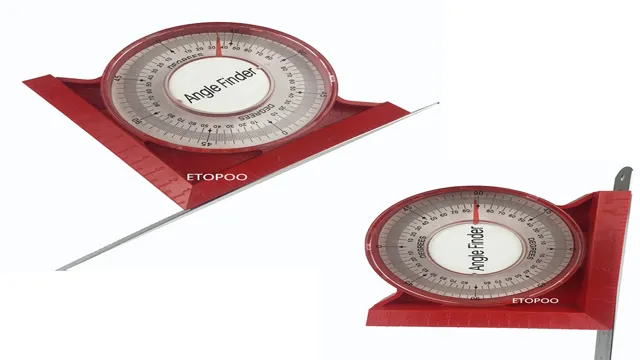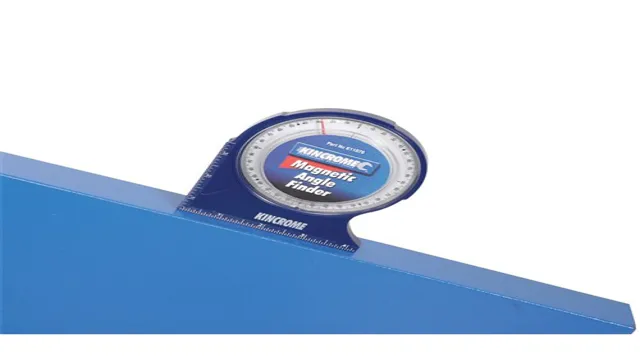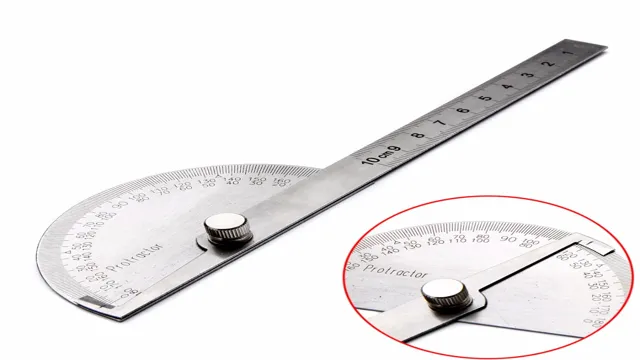
Magnetic angle finder is an indispensable tool for any DIY enthusiast or professional carpenter. Because of its simplicity in design and ease of use, it is no surprise that this device is fast becoming popular among furniture makers, woodworkers, and home renovators. With its magnetic base and protractor, the magnetic angle finder helps in measuring angles with precision, cutting the need for tiresome guesswork.
This gadget not only speeds up your work but also simplifies the process of measuring angles. So why not make your work easier today by adding the magnetic angle finder to your tool collection?
What is a Magnetic Angle Finder?
A magnetic angle finder is a handy tool that helps you measure angles accurately and with ease. It consists of two arms joined together at one end, with each arm attached to a magnetic base. The base attaches to the surface you want to measure, and the arms move to the desired angle.
The angle is then displayed on a protractor attached to one of the arms, or as a digital readout on more advanced models. To use a magnetic angle finder, attach the base to the surface you want to measure, adjust the arms to the desired angle, and read the angle measurement. It’s perfect for projects that require precise angles, such as woodworking, metalworking, or construction work.
With a magnetic angle finder, you’ll get accurate measurements in just a few seconds!
Definition and Purpose
A magnetic angle finder is a tool used to measure angles between two surfaces or objects. It consists of a small level that can be attached to one surface, and a magnetic base that attaches to the other. The level provides a clear indication of whether the surface is level or not, allowing the user to adjust the angle as necessary to ensure a precise measurement.
The purpose of using a magnetic angle finder is to ensure accurate measurements of angles in construction or woodworking projects. It’s particularly useful in situations where it’s difficult to measure angles manually, or where an exact and consistent angle is required. With a magnetic angle finder, you can easily check angles of various objects such as pipes, joints, corners, and more.
It’s an essential tool for any DIY enthusiast or professional who requires precise angles for their work.

Preparing for Use
If you want to ensure that your measurements are as accurate as possible, learning how to use a magnetic angle finder can be a game-changer. Before you start using your magnetic angle finder, it’s important to familiarize yourself with its different parts. This tool consists of two magnetic arms that can be adjusted according to the angle you need to measure.
To use it, place the magnetic base on the surface that you want to measure, and adjust the arms to align with the angle that you want to measure. The magnetic base will hold the angle finder in place while you take your measurements. It’s also important to keep your angle finder clean and in good condition, as any damage or debris on the tool can lead to errors in your measurements.
With a little bit of practice and attention to detail, you’ll be able to use your magnetic angle finder to take precise measurements for a variety of projects.
Gathering Supplies
Preparing for use is a crucial step in gathering supplies. Before using any item, it’s essential to go through proper preparation to ensure that it is safe and ready to be used. This step includes checking for any damages or defects, cleaning the item, and preparing it for use.
For example, if you are gathering camping supplies, you should check your tent for any tears or damages before setting it up. Once you’ve identified any issues, you can repair it accordingly or replace it with a new one. You should also clean the item, removing any dust or debris that may have accumulated on it.
Finally, you should prepare it for use by testing it out in a controlled environment to ensure that it’s working correctly. By taking these steps, you can ensure that your supplies are in good condition and ready to be used whenever you need them.
Calibrating the Angle Finder
When it comes to using an angle finder, the calibration process is crucial to ensure accurate measurements. Before getting started, make sure the angle finder is clean and free of any debris that could interfere with the calibration process. Then, locate the calibration screw or nut on the device.
Use a small screwdriver or hex key to adjust the calibration until the device reads zero when placed on a flat surface. Once this is done, the angle finder is ready to use. Remember to recalibrate the device periodically, especially if it is dropped or exposed to extreme temperatures.
With a properly calibrated angle finder, you can achieve precise angle measurements for your projects and get the job done right.
Using the Magnetic Angle Finder
If you need to measure angles for your DIY projects, a magnetic angle finder is a handy tool to have. Using it is quite straightforward—simply place the flat side of the tool on the surface you want to measure, then adjust the sliding arm to align with the angle you want to measure. The magnetic base will hold the tool in place while you take readings.
Some angle finders come with built-in level bubbles to ensure accuracy. The beauty of this tool is that it saves you time and frustration that come with trial-and-error, allowing you to make precise cuts and measurements. So if you’re working with angles, grab yourself a magnetic angle finder and make your life easier!
Placing the Angle Finder
When it comes to using a magnetic angle finder, placing it correctly is crucial for accurate measurements. The first step is to determine the angle you want to measure. Once you have that figured out, align the long edge of the angle finder with one of the surfaces you want to set your angle to.
You can use the magnet on the bottom to secure it in place. Ensure that the angle finder is parallel to the second surface you want to use to set your angle. Gently move the finder around until you get a reading on the dial or digital screen.
If you’re working on a non-magnetic surface, you can hold the finder in place using a clamp or your hands. Remember, precision is crucial to getting the desired results, so take your time and ensure that the angle finder is positioned correctly. With this simple process, you’ll be able to use your magnetic angle finder effectively and get accurate measurements every time you use it.
Reading the Measurements
When it comes to using a magnetic angle finder, reading the measurements might seem confusing at first, but it’s actually quite simple. The magnetic angle finder is a useful tool for measuring angles of different surfaces. To use it, you’ll need to hold the device against the surface you want to measure and align it with the angle you want to measure.
Then, look at the device’s display screen to read the measurement. The display screen will show the angle measurement in degrees, allowing you to determine the precise angle of the surface. It’s important to note that some magnetic angle finders may have additional features or measurements, such as laser level guides or digital displays, that can help you get more precise readings.
With a little practice, reading the measurements on a magnetic angle finder can become second nature, allowing you to take accurate measurements quickly and easily.
Making Adjustments
If you’re someone who likes to work with precision and accuracy, I highly recommend using a magnetic angle finder to make adjustments. This handy tool is perfect for situations where you need to measure angles on a variety of different surfaces. Simply attach the magnetic base to a flat surface and adjust the arms to measure the angle you need.
The magnetic base ensures that the tool stays in place while you take your measurements, preventing any margin of error. Whether you’re a DIY enthusiast or a professional, a magnetic angle finder is a must-have tool for any toolbox. Its versatility makes it easy to use for a wide range of applications, from woodworking to metalworking to construction.
Invest in one today and make adjustments with ease and precision.
Tips for Accurate Readings
If you want to ensure accurate measurements when using a magnetic angle finder, there are a few tips to keep in mind. First, make sure the surface you are measuring is clean and free of debris. Even small particles can affect the magnet’s ability to cling to the surface.
Next, hold the angle finder close to the surface and level it out so that it is perpendicular to the ground. This will ensure that the reading you get is accurate. If the surface you are measuring is uneven, use shims or other tools to level it out before taking your measurement.
When using a digital angle finder, remember to zero it out before taking a reading. This will give you the most accurate measurement possible. Finally, take your time and make sure the angle finder is securely attached to the surface before taking your reading.
With these tips in mind, you’ll be able to use your magnetic angle finder with confidence and get the results you need.
Checking for Proper Alignment
Getting accurate readings when using a tool that requires proper alignment is crucial. Whether you’re using a laser level, a micrometer, or any other tool that requires precise positioning, taking the time to check for proper alignment can save you from making costly mistakes. One tip to ensure proper alignment is to use a spirit level.
A spirit level is a simple tool that helps you check the level of a surface or object. Place the level on your tool or surface and ensure that the bubble is centered between the two lines. Another tip is to use a target or a guide.
These tools can help you ensure that your measurement is on target and aligned with your desired outcome. With a little attention to detail and the use of a few tools, you can take accurate readings and ensure that your projects are completed to perfection.
Ensuring Secure Placement
When it comes to ensuring secure placement of readings, there are a few key tips to keep in mind. One of the most important is to always make sure that the placement of the sensor is accurate. This means taking the time to properly position the sensor, whether it’s a temperature or pressure sensor, in order to get the most accurate readings possible.
It’s also important to keep the sensor clean, as dust and debris can sometimes interfere with readings. Another important tip is to make sure that the wiring is properly connected and insulated, as this can also affect the accuracy of the readings. Taking the time to follow these simple tips can go a long way in ensuring that your readings are both reliable and secure.
Conclusion
In conclusion, using a magnetic angle finder is so easy even a magnet could do it! Simply attach it to the surface you wish to measure, let it snap into place, and voila! You have the precise angle measurement you need for your project. Whether you’re a DIY enthusiast or a professional carpenter, a magnetic angle finder is an essential tool in your kit. So go ahead and magnetize your measuring game with this nifty device!”
FAQs
What is a magnetic angle finder?
A magnetic angle finder is a tool used to measure angles in various applications.
How do you use a magnetic angle finder?
To use a magnetic angle finder, place the tool on the surface you want to measure, align it with the angle, and read the measurement from the tool.
Can a magnetic angle finder be used on curved surfaces?
Yes, a magnetic angle finder can be used on curved surfaces by adjusting the tool to match the curve.
How accurate is a magnetic angle finder?
The accuracy of a magnetic angle finder can vary depending on the quality and calibration of the tool, but most are accurate within a few degrees.
What are some common applications for a magnetic angle finder?
Magnetic angle finders are commonly used in carpentry, metalworking, and DIY projects for measuring angles and ensuring accurate cuts and joins.
Can a magnetic angle finder be used for measuring vertical angles?
Yes, some magnetic angle finders have a built-in level and can be used to measure both horizontal and vertical angles.
How do you calibrate a magnetic angle finder?
To calibrate a magnetic angle finder, place it on a flat surface and make sure it reads zero. If not, adjust the tool until it does.








